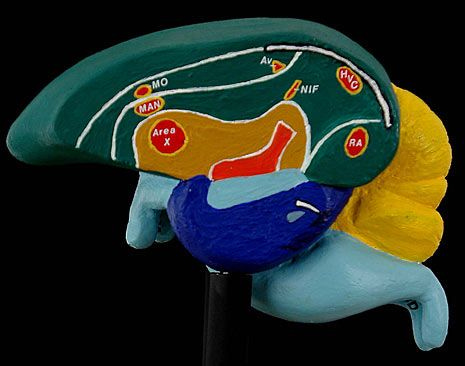Bird-Brained… Really?! A Case for Incredible Intelligence of Birds Despite Our Misleading Caricatures
Bird-brains is a euphemism for an idiot. It basically means that the person has a rather small brain which can’t do much, and therefore has a low IQ and is a moron.
But is that so? If scientists are to be believed, then NO!
Erich Jarvis, a neurobiologist for example, and his team found that 75% of the brains of parrots, hummingbirds, and many other songbirds have a very sophisticated information processing system that works very much like that in humans.
The seven red circles are clusters of neurons. Seen in this view of the brain with about one quarter removed lengthwise, they control the learning (three in the front) and production (four in the back) of vocalizations. These seven neuron clusters are similar among birds that are “vocal learners”—songbirds, parrots, and hummingbirds — and may have some similarities with neuronal language pathways in humans, Erich Jarvis proposes.
Surprisingly, some birds such as parrots can teach and learn hundreds or even thousands of different calls, the basic communication skill that makes human language possible. So-called vocal learning is a kind of intelligence not found in any mammal other than people, bats, dolphins, whales, and elephants. Even chimpanzees and other primates closely related to humans are not as vocally sophisticated as birds.
These are the intelligent birds of the bird kingdom, but what about the pigeons? Well, pigeons could do a lot too!
Burrhus Frederic Skinner, Harvard’s Professor of psychology pioneered his own scientific philosophy called ‘Radical Behaviorism’. Skinner is known for his inventions of the operant conditioning chamber, the cumulative recorder, and the teaching machine. But he is also known for another thing – pigeon guided missiles!
The idea was simple – pigeons would be trained to tap at a “target” on the screen in front of them to control the direction of the missile.
The nose cone of the missile would be split into three compartments, with a lens projecting an image of the intended target onto a screen at the front. A pigeon in each compartment, trained by operant conditioning to recognise the target, would peck at it continually. Pecks to the centre of the screen caused the missile to fly straight, whilst off- centre pecks tilted the screen which would alter the missile’s course.
After much pain, he did get funding from the National Defense Research Committee as well. The results were spectacular!
Test runs were successful; the pigeons pecked reliably, holding the missiles on course even when falling at a rapid pace, undaunted by the terrifying noise of war. Project Pigeon seemed to be taking off. In fact the pigeons were so compliant in his experiments and so rapid in their general behaviour that Skinner vowed never again to work with rats.
However, the “Bird-Brain” Missile Project did not take off as the officials found it strange and also not scalable and reliable over a long period of time. They also thought it wasn’t worth investing in this “technology”.
Maybe we humans were not ready yet to use birds for their brains or as robots, which is a good thing for an animal lover. It certainly spared thousands of pigeons from being slaughtered!
Nevertheless, the misconception that birds – specially the innocuous and “stupid-looking” pigeon – are dumb or “small brained” was proved wrong. But it has done little to enhance the worth of birds when it comes to the world of IQ and intelligence. Isn’t it?
Featured Image source: Flickr





